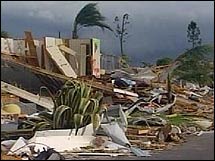|
Rethinking Florida Hurricane-related costs are detracting from the allure of the Sunshine State. NEW YORK (CNNMoney.com) -- The honeymoon with Florida may soon come to an end. For years Americans flocked to the Sunshine State - since World War II, population there has increased 900 percent, to 18 million.
Florida drew migrants with its potent combination of climate, lifestyle and reasonable living costs, especially welcome by retirees on fixed incomes. But the cost advantage is becoming a thing of the past. Real estate prices have soared past national averages, with the median single family house now valued at about $250,000, according to the Florida Association of Realtors, compared with $218,000 for the nation as a whole. Perhaps even more stunning, though, are the big jumps in the cost of insuring property, triggered by a succession of severe storms -- and property damage -- in recent years. In Monroe County, which includes The Keys, property insurance for a five-year-old masonry house valued at $150,000, costs between an average of $3,000 a year from the lowest-cost insurer to an average of $5,779 from the highest. That's with a 2 percent hurricane deductible and a $500 deductible for other damage. All figures are from the Florida Office of Insurance Regulation. Premiums are lower in less exposed place but they keep rising statewide. In April, three insurers filed requests for 8 percent to 51 percent rate increases. On July 6, Nationwide asked for a 71 percent increase. Those premiums don't pay for protection against one important source of damage - flooding. For that, you need separate flood insurance from the National Flood Insurance Program (NFIP), an arm of FEMA. NFIP premiums remain modest and Congress has limited increases to no more than 10 percent a year. But the coverage still adds some $400 or more annually to the average holder's insurance budget. The storms also add to the cost of construction. Post-Hurricane Andrew, in 1992, building codes require stricter storm damage mitigation. That means stronger and more expensive materials and construction methods, according to Jeff Lyons, vice president of consumer relations management for LendingTree, the mortgage loan provider. "Requiring builders to use plywood exterior walls rather than foam core, insulated board, for example, can add to construction cost," says Lyons. Higher demand for materials and labor has also sent prices climbing, he reports. Another culprit Nicole Deg, a 30-year old wife and mother who lives in New Port Richey outside Tampa, already pays $1,700 a year in property insurance premiums. She expects it to rise to more than $4,000 soon. (Her parents, who live around the corner, have already been notified that their premium will go up to $5,000.) Deg says it has nothing to do with the weather. "We haven't had a hurricane here in, like, forever, 40 years or more," says Deg. "It's not about the weather; it's because Citizens is not handling its finances correctly." Citizens Property Insurance Corporation, the quasi-public insurer of last resort, is the state's largest property insurer with more than 1.2 million policies. Citizens plans to hike rates by 139 percent in Deg's home county, Pasco. Deg has become a community activist in a bid to roll back insurance premiums. Citizens blames the hikes on something else - sinkholes. The limestone, that underlies nearly the entire Florida peninsula, according to Ann Tihansky, a hydrologist with the U.S. Geological Survey, is honeycombed with cavities. Soil layers above those holes can collapse and cause sinkholes to form on the surface that can damage buildings. Sinkhole incidents are on the rise. "A lot of the things we do can cause an increase in sinkholes," says Tihansky. Changing the flow of water by paving over areas can accelerate sinkhole formation, for example. Plus, as building densities increases, sinkholes are much more likely to affect people's homes and so be reported. Citizens paid out more than $42 million in sinkhole benefits last year and expects to pay out a lot more in the future, according to Rocky Scott, a spokesman for Citizens. All these cost increases have not resulted in a wholesale shunning of the state; some 1,100 people a day still move in. But if expenses continue their headlong rush up, that could eventually dampen enthusiasm for moving there. Plus, many residents may be weary of going through the storm recovery process again and again. "My parents live on Sanibel Island," says Julie Rochman, senior vice president of public affairs for the American Insurance Association, an industry group. "After Hurricane Charley hit in 2004, people put up all sorts of signs in the area saying 'will pay cash for property.' I think there were quite a few takers."
|
|

